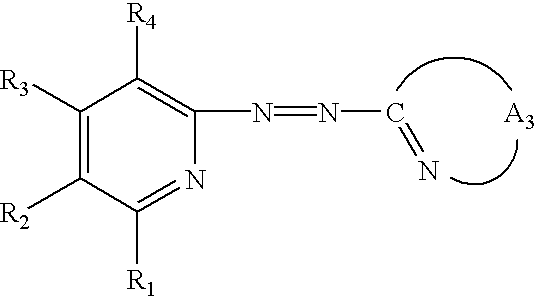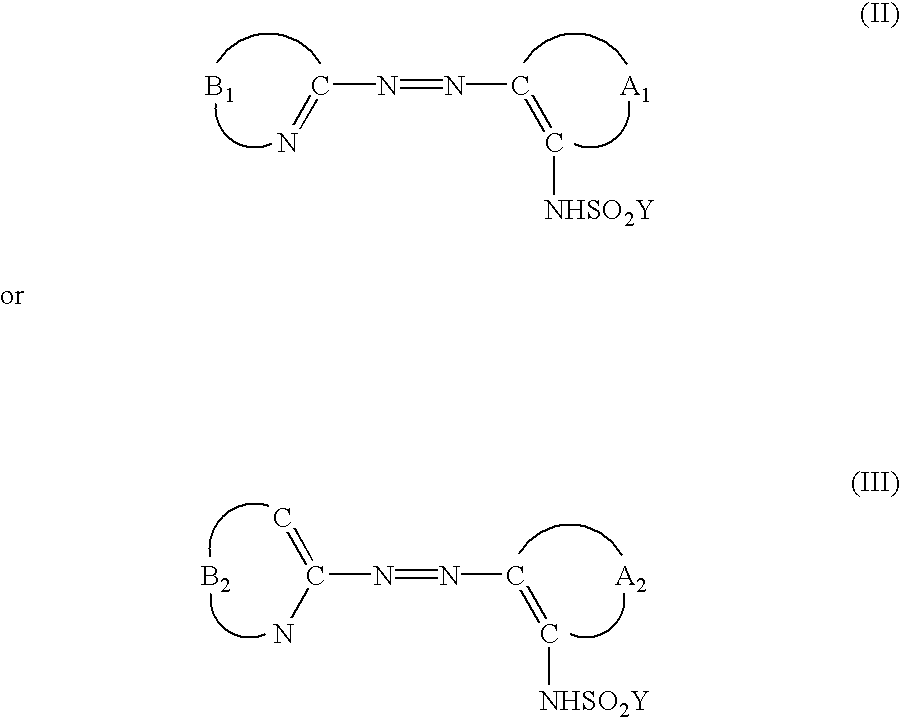Dye for optical recording medium
a technology of optical recording medium and dye, which is applied in the field of dye for optical recording medium, can solve the problems of poor optical stability, inability to meet the audio-visual demand of the next generation, and inability to accommodate the original 650 mb capacity cd-r,
- Summary
- Abstract
- Description
- Claims
- Application Information
AI Technical Summary
Benefits of technology
Problems solved by technology
Method used
Image
Examples
experiment 1
[0042] 5 g of 3-aminoisoxazole is dissolved in 12 ml of acetic acid solution. 12 ml of concentrated sulfuric acid is drop added to the 3-aminoisoxazole solution, followed by adding 11.4 g of nitrosylsulfuric acid under a temperature of 10 degrees Celsius to 30 degrees Celsius. After mixing at a low temperature for about 3 hours, 6 g of urea is added and mixed evenly to obtain solution (A).
[0043] 6.5 g of 2-amino-3-hydroxylpyridine is dissolved in 200 ml of water, followed by adding 6.5 g of sodium acetate. The pyridine solution is then placed in an ice bath. Solution A is slowly drop added to the pyridine solution at a low temperature of 0 to 10 degrees Celsius. After the entire solution A is drop added, mixing is maintained for about 3 hours. Filtering is then performed to collect a solid substance, which is the azo product.
[0044] The above azo product is then dissolved in 30 ml of methanol, followed by drop adding the nickel acetate solution to the azo solution. The nickel acetate...
experiment 2
[0046] 10 gm of the above 3-amino-5-methylthio-1H-1,2,4-triazole is dissolved in 25 ml of acetic acid solution. 12.5 of concentrated sulfuric acid is drop added to the 3-amino-5-methylthio-1H-1,2,4-triazole solution, followed by adding 14.7 g nitrosylsullfuric acid under a temperature of 10 to 20 degrees Celsius. After mixing for about 3 hours at a low temperature, 7 g of urea is further added and mixed evenly to obtain solution (B).
[0047] 13.4 g of 2-bromo-3-hydroxypyridine is dissolved in 500 ml of water, followed by adding 15 gm of sodium acetate. The 2-bromo-3-hydroxypyridine solution is then placed in an ice bath. Solution (B) is drop added at low temperature to the 2-bromo-3-hydroxypyridine solution. After solution (B) is completely added, mixing is continued for 3 hours. Solid substance is collected after filtering, wherein the solid substance constitutes an azo product.
[0048] 7 g of the above azo product is first dissolved in 100 ml of methanol. Nickel acetate solution, whic...
experiment 3
[0050] 8g of 2-aminothiazole is dissolved in 40 ml of acetic acid solution. 20 ml of concentrated sulfuric acid is drop added to the 2-aminothiazole solution, followed by adding 15.2 g of nitrosylsulfuric acid at a temperature of 10 degrees Celsius to 30 degrees Celsius. After mixing for about 3 hours at a low temperature, 7.2 g of urea is further added and mixed evenly to obtain solution (C).
[0051] 8.8 g of 2-amino-3-hydroxylpyridine is dissolved in 640 ml of water, followed by adding 32 g of sodium acetate. The 2-amino-3-hydroxylpyridine solution is then placed in an ice bath. Solution (C) is then slowly drop added to the 2-amino-3-hydroxylpyridine solution. After the solution (C) is completely added, mixing is continued for another 3 hours. Solid substance is collected after filtering, wherein the solid substance is an azo product.
[0052] 3 g of the above azo product is dissolved in 30 ml of methanol. Nickel acetate solution, which is formed by dissolving 3.4 g of nickel acetate t...
PUM
 Login to View More
Login to View More Abstract
Description
Claims
Application Information
 Login to View More
Login to View More - R&D
- Intellectual Property
- Life Sciences
- Materials
- Tech Scout
- Unparalleled Data Quality
- Higher Quality Content
- 60% Fewer Hallucinations
Browse by: Latest US Patents, China's latest patents, Technical Efficacy Thesaurus, Application Domain, Technology Topic, Popular Technical Reports.
© 2025 PatSnap. All rights reserved.Legal|Privacy policy|Modern Slavery Act Transparency Statement|Sitemap|About US| Contact US: help@patsnap.com



